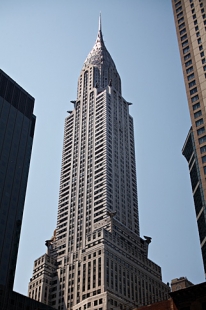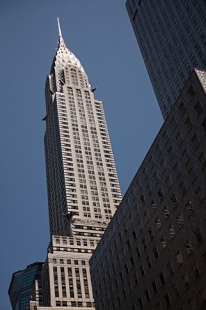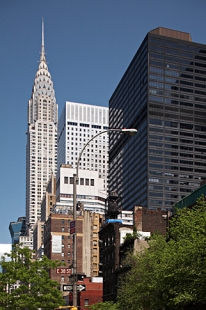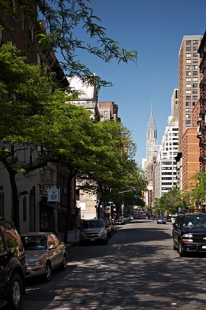
Chrysler Building

The chase for the title of the tallest building in the world
The most beautiful skyscraper built in the art-deco style was born during the race for the title of the world's tallest building, which was one of the main themes of American architecture in the early 1930s. This competition could not be stopped even by Black Friday on Wall Street. The list of competitors includes names whose life stories are intertwined in an incredible way.
When William Van Alen returned in 1911 with a diploma from the Parisian Beaux-Arts school back to New York, he opened his architectural office in the Metropolitan Life Tower, which was then the tallest building in the world. However, as early as 1913, it was surpassed in height by the neo-Gothic Woolworth Building designed by architect Cass Gilbert. This building held its title for a long 16 years until April 1930. Meanwhile, the relatively unknown architect Van Alen was getting increasingly interesting commissions. This was mainly due to his connection with architect H. Craig Severance. However, after eleven years, their successful firm broke apart under tumultuous circumstances, and from 1925 onwards, each had their own practice.
In 1928, the significant industrialist Walter Chrysler approached Van Alen and asked him to build the tallest building in the world. To outpace the other competitors who were also vying for the title of the tallest building, Van Alen had to resort to a small trick. He secretly designed a 56-meter high metal spire for the skyscraper, which was brought to the site in parts. These were assembled inside the building and then raised in just 90 minutes. After this maneuver, the Chrysler Building took the title of the tallest building in the world from the 40 Wall Street skyscraper (later known as the Bank of The Manhattan Company Building or The Trump Building), which could boast of this title for less than two months (from April 1930 to May 27, 1930). The seventy-story skyscraper 40 Wall Street was none other than the former partner of Van Alen, H. Craig Severance, who collaborated with Yasuo Matsui and Shreve & Lamb.
However, Chrysler could only bask in the title of the world's tallest building for just 11 months (May 28, 1930 - May 1, 1931). John Jakob Raskob, former president of General Motors and arch-nemesis of Walter Chrysler, contacted the Shreve & Lamb office, which was involved in the 40 Wall Street project. From their plans, the Empire State Building was born, which managed to hold the title of the world's tallest building until 1972.
Facts
– from May 28, 1930, to May 1, 1931, it was the tallest building in the world
– was the first to surpass the magical height of 1000 feet (305 m)
– the building is topped with a 185-foot (56 m) high spire made of stainless steel
– the original plan was to create a simple building responding to the demand for office space
– construction began on September 19, 1928, and the official opening took place on May 28, 1930
– up to 3000 workers were on site during construction
– at the very top of the building, there was a private club called the “Cloud Club” and an observation deck
– it was one of the first buildings to utilize extensive metalwork on the facade
– the used ornaments refer in various ways to the automotive industry (radiators, bumpers, hood ornaments)
– the eagle heads adorning the tower and the metal spire from the 61st floor up are made of Nirosta, an alloy of chromium, nickel, and steel developed by the German firm Krupp
– the skyscraper has a total of 3,862 windows
– 20,961 tons of steel, 391,881 rivets, and 3,826,000 bricks were used in the construction
– approximately 10,000 light bulbs illuminate the skyscraper at night
– the original lighting design from the 1930s was discovered and installed only in the 1980s
– the lowest office occupancy was 17% during the economic recession in the early 1970s
– the interior is decorated with Egyptian motifs, and the ceiling features a mural by artist Edward Trumbull titled “Transportation and Human Effort,” depicting buildings, airplanes, and scenes from the Chrysler factory assembly line
– the entrance lobby, a unique example of art-deco, is covered with various types of marble, onyx, and amber
– Walter Chrysler sued the architect for accepting bribes from supply companies and refused to pay him his fee. When Van Alen counter-sued Chrysler for his pay, a lien was automatically placed on the building
– although Chrysler lost influence over the building since the 1950s, the skyscraper still bears its name
– a large part of the film Cremaster 3 (2002), by Matthew Barney, takes place in the lobby and atop the skyscraper
The most beautiful skyscraper built in the art-deco style was born during the race for the title of the world's tallest building, which was one of the main themes of American architecture in the early 1930s. This competition could not be stopped even by Black Friday on Wall Street. The list of competitors includes names whose life stories are intertwined in an incredible way.
When William Van Alen returned in 1911 with a diploma from the Parisian Beaux-Arts school back to New York, he opened his architectural office in the Metropolitan Life Tower, which was then the tallest building in the world. However, as early as 1913, it was surpassed in height by the neo-Gothic Woolworth Building designed by architect Cass Gilbert. This building held its title for a long 16 years until April 1930. Meanwhile, the relatively unknown architect Van Alen was getting increasingly interesting commissions. This was mainly due to his connection with architect H. Craig Severance. However, after eleven years, their successful firm broke apart under tumultuous circumstances, and from 1925 onwards, each had their own practice.
In 1928, the significant industrialist Walter Chrysler approached Van Alen and asked him to build the tallest building in the world. To outpace the other competitors who were also vying for the title of the tallest building, Van Alen had to resort to a small trick. He secretly designed a 56-meter high metal spire for the skyscraper, which was brought to the site in parts. These were assembled inside the building and then raised in just 90 minutes. After this maneuver, the Chrysler Building took the title of the tallest building in the world from the 40 Wall Street skyscraper (later known as the Bank of The Manhattan Company Building or The Trump Building), which could boast of this title for less than two months (from April 1930 to May 27, 1930). The seventy-story skyscraper 40 Wall Street was none other than the former partner of Van Alen, H. Craig Severance, who collaborated with Yasuo Matsui and Shreve & Lamb.
However, Chrysler could only bask in the title of the world's tallest building for just 11 months (May 28, 1930 - May 1, 1931). John Jakob Raskob, former president of General Motors and arch-nemesis of Walter Chrysler, contacted the Shreve & Lamb office, which was involved in the 40 Wall Street project. From their plans, the Empire State Building was born, which managed to hold the title of the world's tallest building until 1972.
Facts
– from May 28, 1930, to May 1, 1931, it was the tallest building in the world
– was the first to surpass the magical height of 1000 feet (305 m)
– the building is topped with a 185-foot (56 m) high spire made of stainless steel
– the original plan was to create a simple building responding to the demand for office space
– construction began on September 19, 1928, and the official opening took place on May 28, 1930
– up to 3000 workers were on site during construction
– at the very top of the building, there was a private club called the “Cloud Club” and an observation deck
– it was one of the first buildings to utilize extensive metalwork on the facade
– the used ornaments refer in various ways to the automotive industry (radiators, bumpers, hood ornaments)
– the eagle heads adorning the tower and the metal spire from the 61st floor up are made of Nirosta, an alloy of chromium, nickel, and steel developed by the German firm Krupp
– the skyscraper has a total of 3,862 windows
– 20,961 tons of steel, 391,881 rivets, and 3,826,000 bricks were used in the construction
– approximately 10,000 light bulbs illuminate the skyscraper at night
– the original lighting design from the 1930s was discovered and installed only in the 1980s
– the lowest office occupancy was 17% during the economic recession in the early 1970s
– the interior is decorated with Egyptian motifs, and the ceiling features a mural by artist Edward Trumbull titled “Transportation and Human Effort,” depicting buildings, airplanes, and scenes from the Chrysler factory assembly line
– the entrance lobby, a unique example of art-deco, is covered with various types of marble, onyx, and amber
– Walter Chrysler sued the architect for accepting bribes from supply companies and refused to pay him his fee. When Van Alen counter-sued Chrysler for his pay, a lien was automatically placed on the building
– although Chrysler lost influence over the building since the 1950s, the skyscraper still bears its name
– a large part of the film Cremaster 3 (2002), by Matthew Barney, takes place in the lobby and atop the skyscraper
The English translation is powered by AI tool. Switch to Czech to view the original text source.
2 comments
add comment
Subject
Author
Date
Cremaster 3
Petr Šmídek
29.08.07 10:27
Chrysler Building
Roman
29.08.07 04:51
show all comments
















